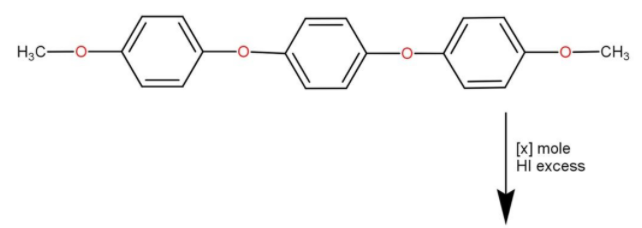
How many moles of $HI$ will be consumed in the given reaction?

A. 3 moles
B. 2 moles
C. 1 mole
D. 4 moles

Answer
457.5k+ views
Hint:We can reduce carbonyl compounds and esters to alcohol using strong reagents like $LiA{H_4}$ or $HI$. If the reducing agent is mild like HI, then alcohol is formed. If the reducing agent is strong like Zn/HCl, then the carbonyl group is reduced to hydrocarbons.
Complete answer:
We know that ethers are compounds with ${\text{R}} - {\text{O}} - {\text{R}}$ structure, where R is some alkyl group.In the question, we can see that it has two ${\text{R}} - {\text{O}} - {\text{R}}$ structure at both endings. Also, we are aware of the fact that $HI$ is a strong reducing agent. When we reduce esters we get alcohol. This is the properties of ester as well as the preparation of alcohols. For preparation, we use $LiA{H_4}$ since they are stronger reducing agents than $HI$.We know that in ${\text{R}} - {\text{O}} - {\text{R}}$ there are two lone pairs in hydrogen making them highly reactive toward acidic substances.
The $HI$ dissociates into ions as shown below
$HI \to {H^ + } + {I^ - }$
The ${H^ + }$ produced will reactivate the lone pairs of O-atoms in ethers. When considering our question we have a total of 4 oxygen atoms. The last two oxygen atoms are attached to the $ - C{H_3}$ group. Those will have less steric hindrance to them making them more reactive towards $HI$
Now we will discuss what is meant by steric effect or steric hindrance, it happens when a large sized group prevents molecules from the chemical reaction happening. Since we have a large phenyl group attached to two of the oxygen atoms, it is less likely to get reacted with strong reducing agents. The last two of them will get reacted to $HI$ and the ${I^ - }$ will combine with the large phenyl part at the ${H^ + }$ will combine with $O - {\text{C}}{{\text{H}}_3}$ to form alcohol. This will happen at the both ends, hence we need two moles of $HI$
i.e., option B is correct
Note:
At first it may occur like 4 moles is required, but here we must not forget to consider the steric effect. If we do not consider it may look like we need 4 moles, which is wrong.
Complete answer:
We know that ethers are compounds with ${\text{R}} - {\text{O}} - {\text{R}}$ structure, where R is some alkyl group.In the question, we can see that it has two ${\text{R}} - {\text{O}} - {\text{R}}$ structure at both endings. Also, we are aware of the fact that $HI$ is a strong reducing agent. When we reduce esters we get alcohol. This is the properties of ester as well as the preparation of alcohols. For preparation, we use $LiA{H_4}$ since they are stronger reducing agents than $HI$.We know that in ${\text{R}} - {\text{O}} - {\text{R}}$ there are two lone pairs in hydrogen making them highly reactive toward acidic substances.
The $HI$ dissociates into ions as shown below
$HI \to {H^ + } + {I^ - }$
The ${H^ + }$ produced will reactivate the lone pairs of O-atoms in ethers. When considering our question we have a total of 4 oxygen atoms. The last two oxygen atoms are attached to the $ - C{H_3}$ group. Those will have less steric hindrance to them making them more reactive towards $HI$
Now we will discuss what is meant by steric effect or steric hindrance, it happens when a large sized group prevents molecules from the chemical reaction happening. Since we have a large phenyl group attached to two of the oxygen atoms, it is less likely to get reacted with strong reducing agents. The last two of them will get reacted to $HI$ and the ${I^ - }$ will combine with the large phenyl part at the ${H^ + }$ will combine with $O - {\text{C}}{{\text{H}}_3}$ to form alcohol. This will happen at the both ends, hence we need two moles of $HI$
i.e., option B is correct
Note:
At first it may occur like 4 moles is required, but here we must not forget to consider the steric effect. If we do not consider it may look like we need 4 moles, which is wrong.
Recently Updated Pages
Questions & Answers - Ask your doubts

Master Class 11 Accountancy: Engaging Questions & Answers for Success

Master Class 11 Science: Engaging Questions & Answers for Success

Full Form of IASDMIPSIFSIRSPOLICE class 7 social science CBSE

In case of conflict between fundamental rights of citizens class 7 social science CBSE

Using the following information to help you answer class 12 chemistry CBSE

Trending doubts
Which are the Top 10 Largest Countries of the World?

Differentiate between homogeneous and heterogeneous class 12 chemistry CBSE

Draw a labelled sketch of the human eye class 12 physics CBSE

What is a transformer Explain the principle construction class 12 physics CBSE

What are the major means of transport Explain each class 12 social science CBSE

How much time does it take to bleed after eating p class 12 biology CBSE




